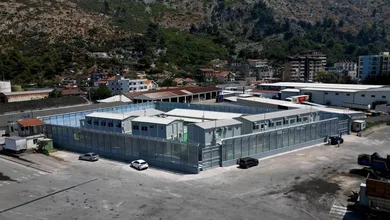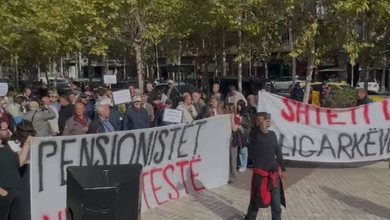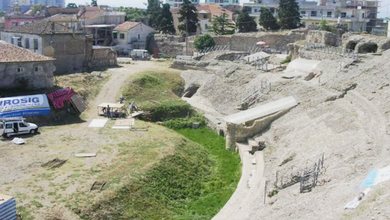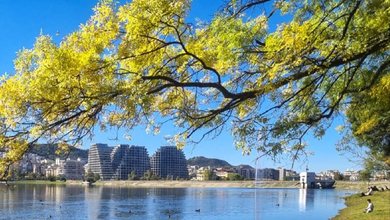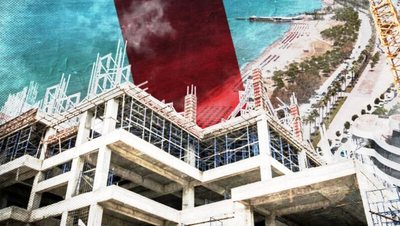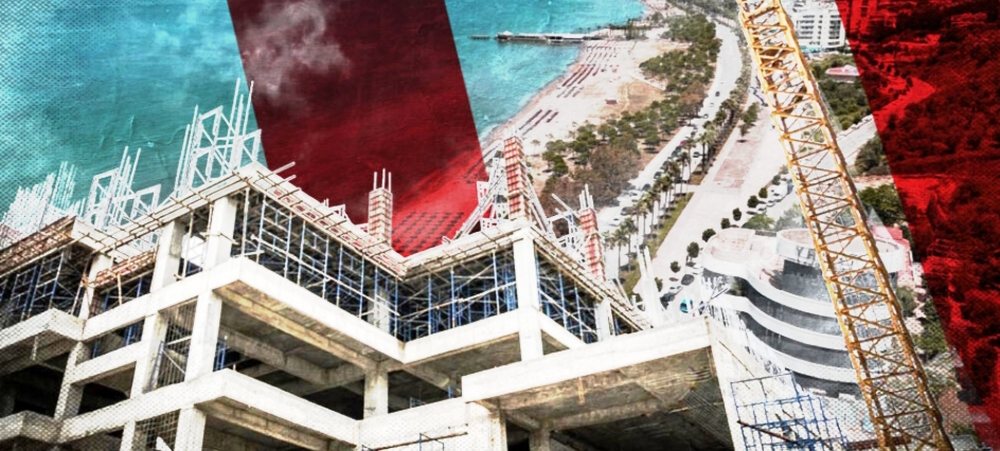
Durrës and Vlora are two of the most important regions of the country and are examples of how Albania has developed during the transition. For the political forces that have governed the country, they are considered success stories.
But, despite the government's desire to offer us this picture, the 2023 census data shows a different reality, where almost half of the homes in these two districts are empty.
This fact raises serious questions about the economic development model of these two important centers, in which significant investments have been made in construction. However, data shows that the majority of new buildings are unoccupied.
Only 7% of the residents of Durrës district and 2% of the residents of Vlora live in housing built between 2016-2023.
Durrës, one in two apartments is empty.
The Durrës region, the second most important in the country, includes the municipalities of Durrës, Shijak and Krujë and has 226,863 inhabitants, with a decrease of 36,848 inhabitants (14%), compared to the 2011 census.
On paper, it is a dynamic area with the country's largest port, proximity to Tirana, and a coastline that attracts investment and tourism.
But the picture is not so optimistic. According to the 2023 census, there are 117,303 dwellings in the Durrës region, of which 51,127 (43.6%) are empty, while 66,176 are inhabited.
The situation becomes more dramatic when the allocation of empty apartments is done at the municipal level.
The Municipality of Durrës contains the vast majority of vacant units. In total, it has 91,378 housing units, of which 46,7938 (51.2%) are occupied while 44,595 (48.8%) are not. This indicates that almost half of the housing units are vacant.
In Shijak and Kruja, where pressure from tourism and construction has been felt less, the figures are lower, with vacancy rates of 32.5% and 21.3% respectively.
As Albania's population shrinks, as a result of mass emigration and the fact that Tirana is the one that attracts even the few residents from internal demographic movements, Durrës has become a "concrete warehouse" for apartments awaiting summer vacationers, emigrants with savings, or investors and speculators focused on the real estate market.
But not for the people who live and want to live there every day.
In the Durrës region, 779,000 m2 of construction intended solely for residential purposes have been added from 2013 to 2024.
Vlora worse than Durres
Vlora is the region where the phenomenon of empty homes is most pronounced. On paper, Vlora is a success story, with strategic investments, growing tourism, and rapid coastal development.
According to the 2023 census, the population of Vlora district has decreased by 28,959 (17%) since 2011.
In total, the region has 109,375 residential dwellings, of which 52,296 are occupied (47.8%), while 57,079 (52.2%) are not. More than half of the houses in the Vlora region are empty.
In the municipality of Vlora, which includes the city itself and the surrounding areas, out of 63,428 dwellings in total, 33,561 are empty (53%), while 29,867 (47%) are inhabited.
In Saranda, another model of Albanian tourism development, the phenomenon is even more pronounced: out of 20,790 homes, 12,919 are empty, and only 7,871 have people inside.
In percentage terms, this means 62% empty apartments and only 38% occupied.
Himara, another similar tourist destination, has 7,292 dwellings, of which 4,173 are empty (57%) and 3,119 (43%) are occupied.
In Delvina, Konispol and Finiq, areas that have not felt the same pressure for construction and tourism, only approximately 1 in 3 apartments is empty.
Selenica is an exception in the Vlora district with a high level of vacant housing despite not being a tourist area.
For urban planner Doriana Musai, construction has become an economic model to keep "development statistics" alive.
“The government proclaims successes with words like 'tourism', 'strategic investments' and 'modernization', but in reality it is creating ghost towns, where half the windows never light up,” says Musai.
93-98% of residents of Vlora and Durrës live in buildings built before 2016
The census of two years ago, in addition to the number of empty and occupied homes, also shows the age of the buildings where residents of the two regions live.
But the Institute of Statistics has published this data only at the district level; at this stage, data at the municipal and administrative unit level is missing.
We asked INSTAT to make this data available to us, but after several communications with representatives of this institution and the Commissioner for the Right to Information, we were told that this data was being processed and would be made available to us once this process was completed.
However, based on what is public, we have been able to build an idea of where the residents of the Durrës region live.
Of the total of 66,176 residential units in Durrës at the prefecture level, the graph below shows us where the citizens of the district reside, grouped by the year the dwelling was built.
More than half of the residential units in Durrës (57%) were built before 2000.
Housing built in the years 2001-2010 accounts for 30% of the total number of occupied housing units, while those built after 2010 account for 14% of the total number of occupied housing units.
More than half of the district's residents live in apartments built during communism or the early years of democracy, not those of the post-2000 construction wave.
Whereas, in Vlora, the total of 52,296 residential units is divided according to the graph below.
In this district, the fact that the majority of residents live in old apartments becomes even more evident, highlighting that apartments built after 2000 tend to be empty.
Two out of three residential units were built before 2000.
Housing built in the years 2001-2010 accounts for 23% of the total number of occupied housing units. While housing built after 2010 accounts for only 8% of the total number of occupied housing units.
Two-thirds of the district's residents live in homes built during communism or the early years of democracy, not those from the post-2000 construction wave.
In the Vlora region, 722,000 m2 of residential construction were approved from 2013 to 2024. It is worth noting that in 2014 alone, 266,000 m2 of residential construction were granted.
New housing units after 2016 occupy a very small percentage of the total number of inhabited houses, in Durrës 7% and in Vlora 2%. So, new buildings are not replacing the old ones, but are added on top of them.
We also requested data from INSTAT on vacant housing units in these two districts, to determine which administrative units and which construction period the vacant housing units belong to, but we were unable to obtain this information with the same argument that the data is being processed.
The construction industry, for urban planner Doriana Musai, is highly exposed to the two phenomena of speculation and money laundering, and real estate investments have become a haven for unsafe capital, including corruption and financial crime.
"In the absence of other safe markets, concrete has become the safest 'bank' for savings, often of dubious origin. SPAK confirms this established scheme in many cases," says Musai.
Comparing Durres and Vlora with Thessaloniki
A strange phenomenon is occurring in these two counties: the population has decreased from census to census, empty homes have increased, but the number of meters of residential construction has also increased.
According to a study conducted by three professors (Azmi Stringa, Manjola Naco and Alban Korbi), it is said that the share of uninhabited units increased and along with them the price of real estate increased.
According to the Bank of Albania, apartment prices increased by approximately 44% in 2024.
Multiple factors are contributing to this growth: expanding tourism and demand for daily rentals (short-term such as Airbnb), speculative home purchases, and a growing share of purchases by foreign buyers, estimated at 20% of transactions in 2024.
"This combination of the lack of other investment alternatives, the country's risk profile (uncertainty in doing business drives investment in real estate), speculative investment, external demand from tourism, corruption and financial crime is producing a paradoxical result, as Albania's population is declining, the number of empty homes continues to grow and prices escalate beyond the means of average citizens," the study states.
The study makes a comparison with an important tourism center in Greece, such as Thessaloniki, and this area is significantly better than Durrës and Vlora. According to Greek media, one in three houses in the Central Macedonia region is empty, or about 33%.
While Durrës and Vlora are around 50% with a trend of increasing this figure because the "Durrës Yacht Marina" and "Vlora Marina" projects will bring thousands of more apartments to the market.
Doriana Musai says that an economy of illusions is being built, where "development" is not measured by increasing people's quality of life, but by the number of building permits and m² of concrete sold.
"In this sense, Durrës and Vlora are becoming victims of false success, becoming tourist cities for some, but uninhabited for the majority," concludes Musai./Citizens


